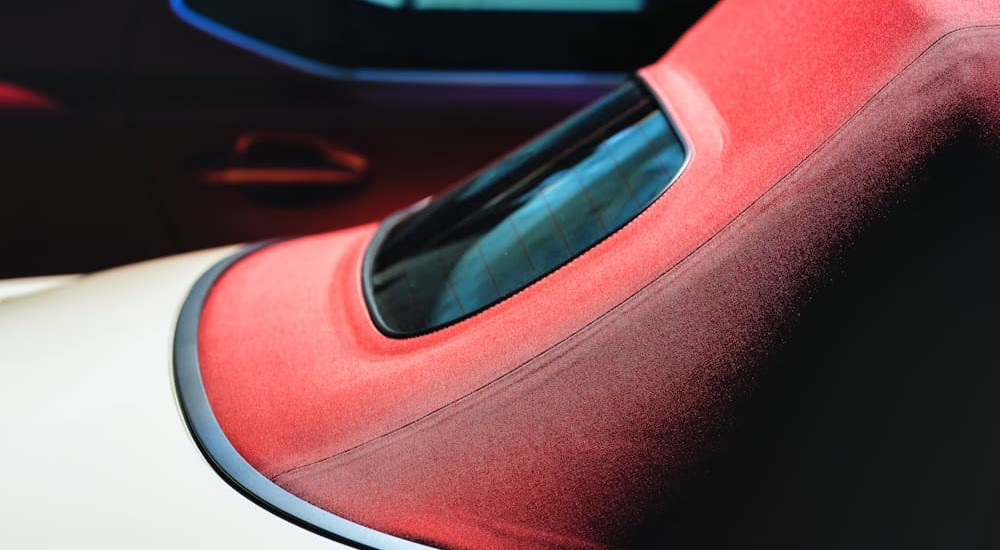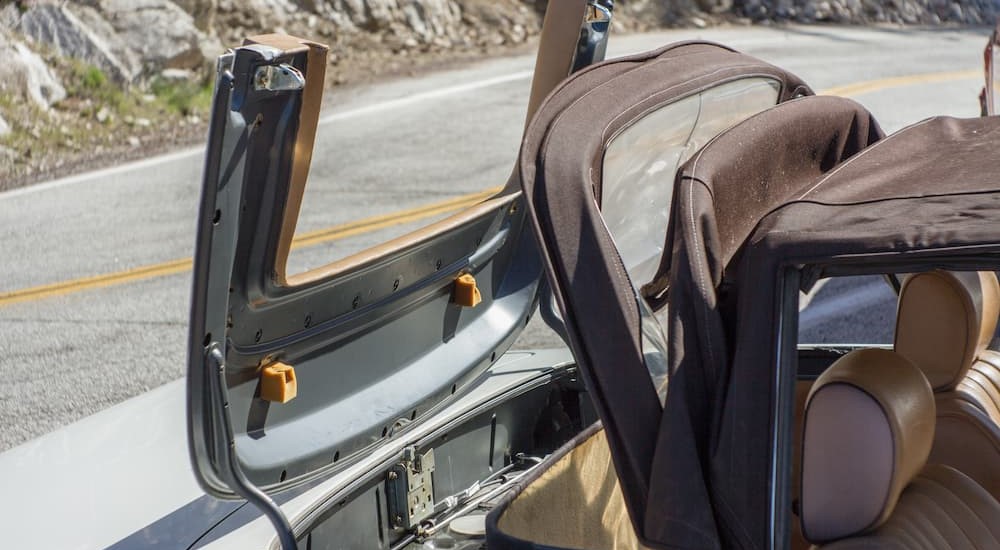From the wind-in-your-hair feeling to cruising down the road with sunshine on your face, there’s a lot to love about the convertible lifestyle. For the uninitiated, the segment is largely broken down into two categories: soft tops and hard tops. A soft top convertible is any model with a vinyl or fabric roof covering, as opposed to hard tops, which have roofs made from sections of metal or plastic. Soft tops are usually more affordable, faster to deploy, and have more cargo space than hard tops, which typically fold into the space normally reserved for a trunk.
That said, soft tops do come with some disadvantages when compared to hard tops. A hard top convertible does a better job of reducing road noise from seeping into the cabin and also provides better insulation than many soft tops, though that’s less of a concern as convertibles are usually stored away during the colder months. Most importantly, hard tops don’t require the same level of upkeep as soft tops, which are more susceptible to the elements. How’s a driver supposed to protect their soft top convertible from succumbing to damage from sun, rain, and stain exposure? Follow along as we review some of the best practices for convertible soft top care and learn how easy it is to keep your convertible looking its best.

Vinyl vs Fabric
Convertible soft tops generally come in two flavors: vinyl and fabric. While the materials perform the same function––namely, keeping you dry and protected from the elements––they do require different approaches when it comes to cleaning, detailing, and care. Before we get into the specifics, let’s take a quick look at each material and see how they compare.
If you’re not sure whether you’re dealing with a vinyl or fabric soft top, there’s an easy test you can perform to find the answer. Simply splash a little water on your convertible’s roof, rub it with your finger, and see what happens. If the water is absorbed into the material, you’re probably dealing with a fabric roof. If, on the other hand, the water beads up, smears, or otherwise stays on the surface of the material, it’s probably a vinyl roof. If the test is inconclusive, take a quick look at the owner’s manual that came with your convertible, as it should include a section on soft top care and maintenance that will also clue you into its construction.
Vinyl
Vinyl has long been the go-to material for soft top convertibles and was even a popular choice for some hard top vehicles in the 1970s and 1980s. The vinyl material offers a number of advantages over fabric soft tops, starting with how easy it is to clean. Vinyl soft tops are waterproof, meaning that they can usually be cleaned along with the rest of the car instead of requiring their own specific regimen.
Many drivers also prefer the look of a vinyl soft top due to its comparably shiny appearance, and they also tend to offer a little more protection thanks to the strength of the material. However, they come with one major downside: cracking and peeling. If not properly cared for, vinyl soft tops tend to develop unsightly blemishes that often require the entire roof to be replaced, which can be a real financial hurdle for drivers on a budget.
Fabric
Fabric soft tops, also referred to as canvas soft tops, are a popular alternative to vinyl coverings due to their longevity. Typically made from three layers of material that include an acrylic outer layer, a rubber middle layer, and a cotton lining, fabric soft tops might not offer the same protection as vinyl soft tops, but they sure look good. Many drivers prefer the matte look of fabric soft tops, not to mention the fact that, unlike vinyl soft tops, they can be easily repaired instead of requiring wholesale replacement.
This is good news for any driver looking to save some money, but fabric soft tops will require a little more vigilance than their vinyl counterparts. Fabric soft tops require regular cleaning to look and work their best and, unlike vinyl soft tops, can’t simply be washed along with the rest of the car. Fabric soft stops require special cleaning solutions, tools, and techniques, making them the more time-intensive of the two materials.

Cleaning
Vinyl
Cleaning a convertible with a vinyl soft top isn’t that much different from the way you would normally wash your vehicle, but there are a couple things to keep in mind. First off, we’d recommend using a relatively gentle car wash formula as many products include harsh chemicals and gloss enhancers, which can damage even a vinyl soft top. If your vinyl soft top is particularly grimy, you might consider springing for a specially formulated convertible top cleaner. These chemicals are designed to break down grease, film, and other contaminants that might have found their way onto the vinyl and often include compounds aimed at preventing mold and mildew.
When it comes to convertible top cleaners, instructions tend to vary by manufacturer. Generally speaking, you’ll want to spray the soft top with water, work in some cleaner with a gentle scrubbing motion and then give the vinyl a good rinse. Speaking of scrubbing, many experts recommend using a convertible top brush with feathered bristles to work car wash or cleaner into the vinyl. These brushes are built with convertible soft tops in mind and offer improved performance over the run-of-the-mill car wash brushes you’ll find at the local auto parts store.
Fabric
Cleaning a convertible with a fabric soft top isn’t that much different than a vinyl soft top; it just tends to require a few more specialized products. This is due to the more porous nature of the fabric covering, as well as the fact that they’re typically treated with compounds designed to make them water and stain-resistant. These compounds can wear away over time if the correct cleaning products aren’t used, compromising the integrity of the fabric soft top and opening drivers up to staining and water damage.
These treatments can be reapplied if need be, but they’ll last much longer if you develop a regular cleaning habit. There are a number of brands offering car wash products specifically aimed at fabric soft tops, and unlike vinyl soft tops, it’s important that you don’t cheap out and go with a general-purpose car wash. You’ll also need to buy a more rigid brush than the type you would use on a vinyl soft top, as it takes a little more stiffness to work dirt and grime out of the woven fabric.
Protecting
A regular washing routine helps to keep a convertible soft top looking its best, but that is only part of the equation. If you’re looking to protect your vehicle’s soft top between washes, there are a number of products on the market that do just that. These protectants not only help prevent the build-up of dirt and grease on the soft tops, but they can also minimize discoloration and prevent UV rays from wreaking havoc on the vinyl or fabric.
Just be warned: not all protectants are created equal, so make sure you find a product that’s specifically designed for either a vinyl or fabric soft top. Vinyl soft top protectants can be applied in a single coat once a month, while fabric protectants often require a few applications with ample drying time between each coat. Make sure not to saturate the area when applying a fabric protectant, and perform the procedure at least once a month if your convertible is seeing regular use.

Maintaining
Aside from cleaning and protecting, there are a few general guidelines around convertible soft top maintenance that are important to keep in mind. This one should probably go without saying, but soft top convertible owners should avoid automatic car washes at all costs. They might be convenient, but the extreme water and air pressure they can exert on the soft top can have some disastrous effects. If the rear window of your soft top is made of plastic, don’t use glass cleaner on it, as it can create fogging over time. Instead, use a soft microfiber towel and water.
Tackling minor rips, punctures, and stains as quickly as possible is also important, as these small issues have a tendency to snowball into larger repairs if not promptly addressed. If your convertible is going to be out of use for an extended period of time, don’t leave the soft top down, as it can become creased and fragile over time. Lastly, never force the top closed if you’re having trouble getting it stowed away. There are simply too many fragile parts in the soft top assembly, and any unexpected force can cause some lasting damage that’ll have you wishing you had been a little more patient.
The Extra Care Is Worth It
If you’re looking for a one-of-a-kind driving experience, it’s hard to match the novelty of a convertible. That said, the segment does come with some unique challenges, with cleaning and care of the soft top ranking chief among them. While vinyl and fabric soft tops might require a few specialized tools, cleaning solutions, and treatments to keep them in tip-top shape, it’s well worth the effort when you consider just how fun a convertible can be. It’s all too easy to put off necessary maintenance and cleaning, but if you let these tasks fall by the wayside, you could end up paying a steep price.
While non-convertible vehicles offer a little more wiggle room, a lapse in your regularly scheduled maintenance could mean a premature end for your convertible’s soft top as it succumbs to the ravages of UV exposure, dirt, rain, and assorted road grime. Remember: a convertible might be at its most fun when the top is down, but when inclement weather comes calling, you’ll be glad you didn’t neglect your soft top routine.

